Over the offseason, I wrote an article detailing how Kyle Seager needed to get back to doing what he does best. That is, hitting the ball as hard as he can, often to his pull side.
At this point, it seems obvious that Seager was hampered by a pretty serious injury in 2018. If it’s still not obvious, well: Seager was hampered by a pretty serious injury in 2018. It seemed unlikely that Seager’s production was going to fall off a cliff at the age of 30, but now we can be more confident that Seager isn’t drastically declining. 2018 can be best explained by a major toe injury, and after shaking off some rust, Seager has been insanely productive for a few months now.
This is, on one hand, surprising, and on the other hand wholly unsurprising. Seager has been underperforming for a number of years, in part because of the shift, and yet he’s also been one of the most durable, consistent hitters since he’s been an everyday member of the Seattle Mariners‘ lineup. So when there was talk of a slimmer, trimmer Seager over the offseason in an effort to stay as healthy and effective as possible, I met it with an eye roll but also with hopeful optimism. Of course, out of pure bad luck, Seager ended up jamming his hand diving for a ball in spring training and losing most of his 2019 to injury. But after having some time to shake off the rust, Seager has come back and been one of the most of the productive hitters in the league in the past two months—and his peaks have been as high as they’ve ever been in his career.
First, Seager’s rolling xwOBA, per 50 plate appearances:
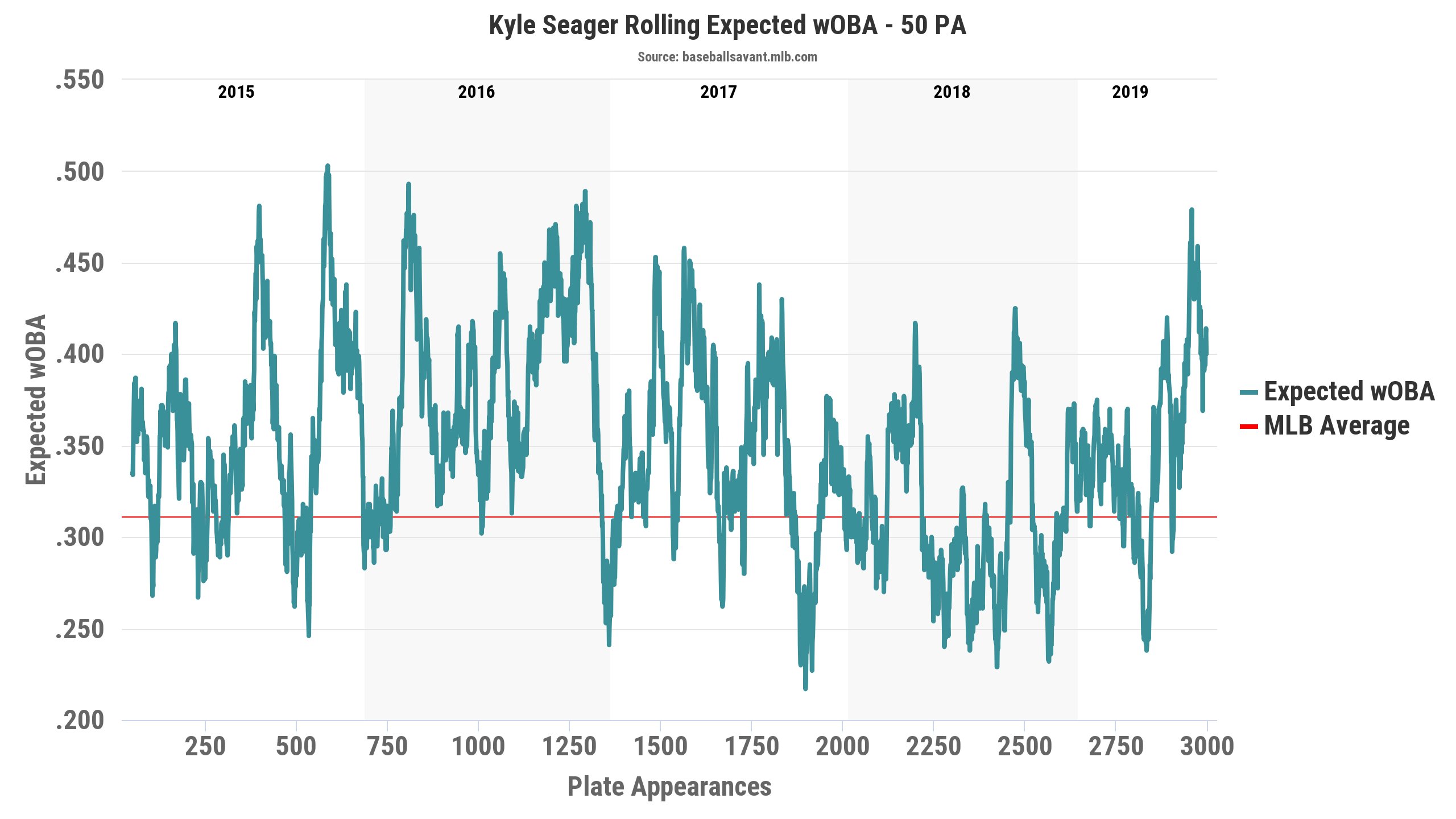
Next, Seager’s rolling wOBA, per 50 plate appearances:
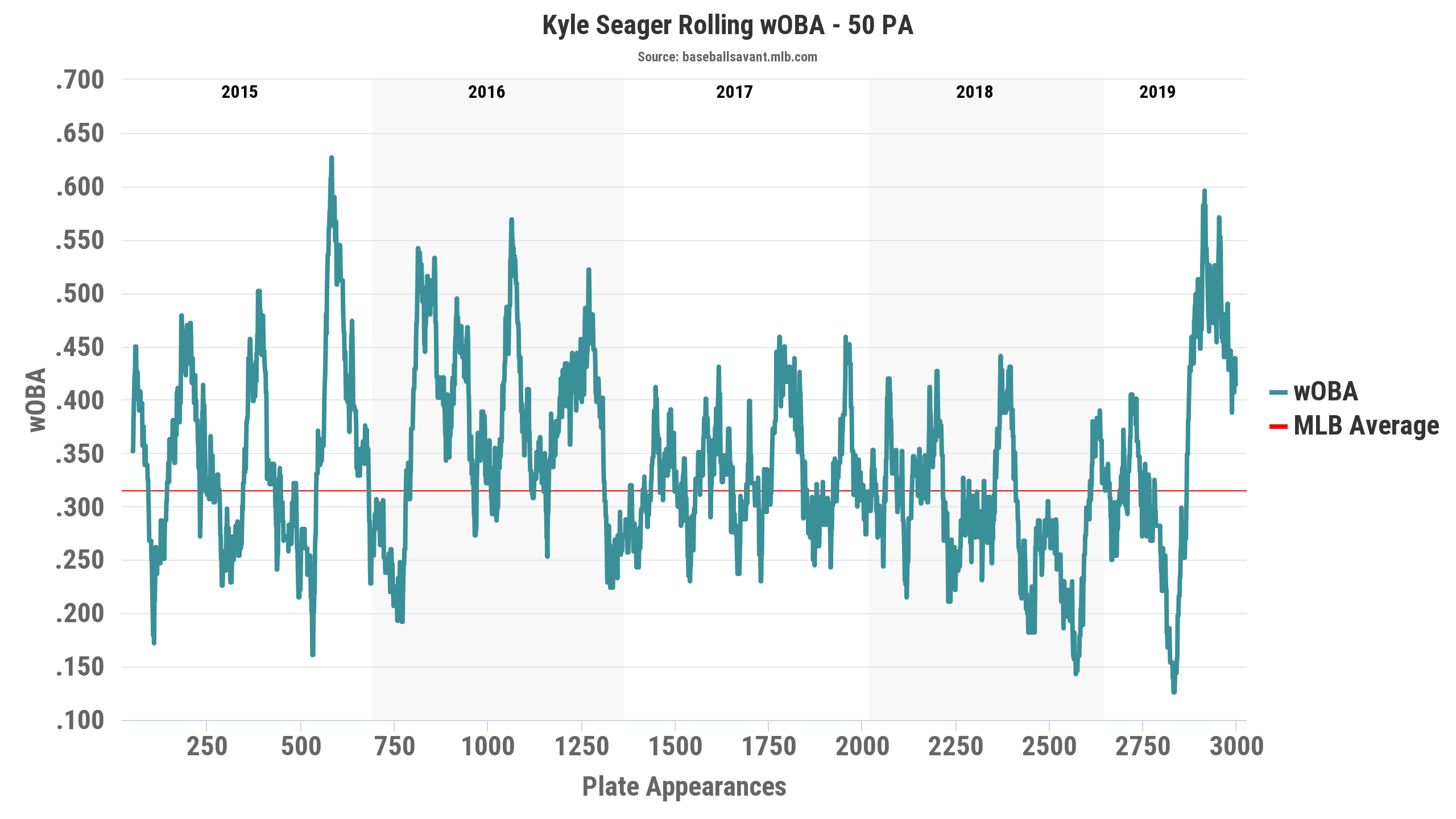
So by xwOBA, Seager’s peak in 2019 is the best he’s been over a span of 50 plate appearances since 2016. By wOBA, though, it’s the best he’s been since 2015.
Our analysis could stop there, I suppose, but there are multiple reasons for a revitalized Seager. There’s some good, and there’s some less-good, but I want to start with the good.
First, a tweet from my colleague Alex Fast:
% of pitches swung at in 0-0 counts:
2019: 29.1 🔺
2018: 28.3 🔺
2017: 28.0 🔺
2016: 27.6
2015: 28.1 🔺
2014: 26.6 🔺
2013: 26.2 🔺
2012: 25.6
2011: 25.8 🔺
2010: 25.1Batters are more aggressive in 0-0 counts than they've been in the past 10 seasons. From an upcoming article.
— Alex Fast (@AlexFast8) June 19, 2019
Across the league, hitters are ever so slowly starting to become more aggressive on the first pitch. That’s because 0-0 counts are one of the most hitter-friendly counts because of the high frequency of fastballs.
One more time, from Fast:
Love it. Why let a pitcher get to his best stuff?
— Alex Fast (@AlexFast8) July 28, 2019
Indeed: Why let a pitcher get to his best stuff? Here’s a (sortable!) table, showing fastball frequency in every type of count:
| Count | FA% |
|---|---|
| 0-0 | 62.10% |
| 0-1 | 54.50% |
| 0-2 | 49.60% |
| 1-0 | 61.30% |
| 1-1 | 54.30% |
| 1-2 | 48.60% |
| 2-0 | 74.40% |
| 2-1 | 61.30% |
| 2-2 | 51.70% |
| 3-0 | 95.20% |
| 3-1 | 79.10% |
| 3-2 | 64.00% |
| Hitter Ahead | 66.20% |
| Hitter Behind | 51.40% |
| Even | 58.30% |
| 2 Strikes | 52.40% |
| 3 Balls | 71.80% |
As you can see (or maybe cannot see, because the table is rather large), there are only four total counts in which a hitter is more likely to see a fastball than in 0-0 counts. The problem is, those counts—2-0, 3-0, 3-1, and 3-2—are difficult to work yourself into. In other words, if you’re seeing a good pitch in an 0-0 count (and you probably will), perhaps you should swing. This is something that I wrote about Christian Yelich doing well and what several others are starting to warm up to.
Seager is putting more balls into play—the number of balls put into play in 0-0 counts has risen from 9.8% from 2015-2018 to 17.2% in 2019. The encouraging thing is, the amount of his hits that have come in 0-0 counts has risen (albeit slightly), from 15.2% to 16.2%. It’s a small improvement but an improvement.
Here is how Seager has performed in 0-0 counts via wOBA and xwOBA, by year:
| wOBA | xwOBA | wOBA – xwOBA | |
|---|---|---|---|
| 2015 | 0.438 | 0.415 | 0.023 |
| 2016 | 0.522 | 0.467 | 0.055 |
| 2017 | 0.471 | 0.416 | 0.055 |
| 2018 | 0.335 | 0.386 | -0.051 |
| 2019 | 0.394 | 0.414 | -0.020 |
| Since July 6th | 0.535 | 0.454 | 0.081 |
You will notice that a few things: Since July 6, his wOBA is the highest it’s been, and his xwOBA is the best it’s been since 2016. Obviously, we’re pulling from a hot streak, but it’s also a span of two months. So we’ve now shown that (a) Seager is getting more hits in 0-0 counts, and (b) he’s also been as productive as ever.
As I said before, it’s often better for hitters to attack early because the first pitch is often the most favorable because it’s frequently a fastball in the zone. Since July 6, he’s been more productive in 0-0 counts than ever—only bested by the .467 xwOBA he posted in 2016. There are several reasons for this, but one has to do with selectivity.
Seager’s fastball heatmap in 0-0 counts, from 2015-2018:
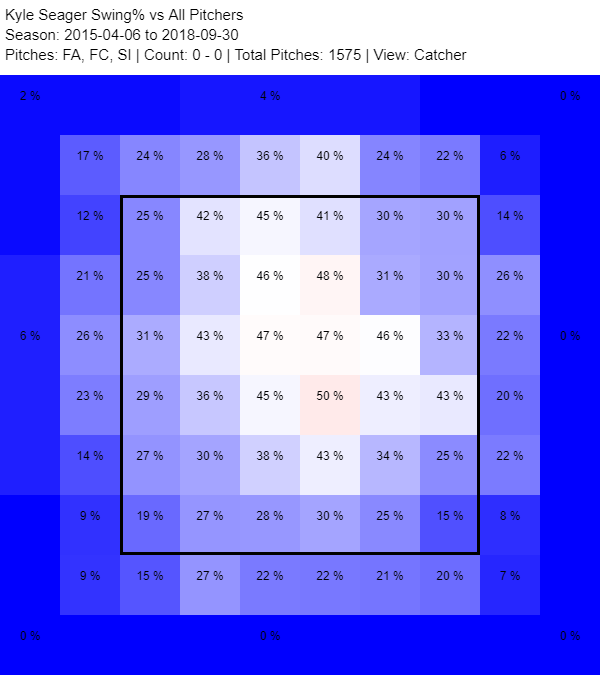
And then Seager’s fastball heatmap in 0-0 counts, in 2019:
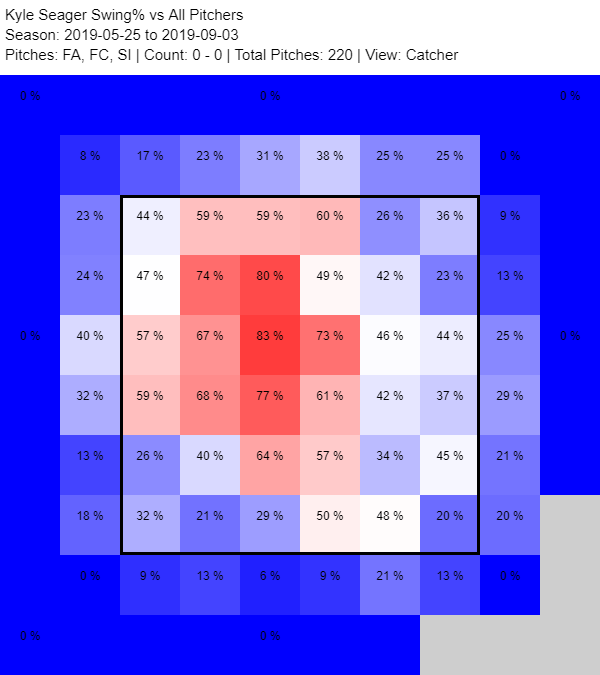
He’s not only started to increase the area in which he’ll swing at first-pitch strikes, but he’s also really, really honed in the middle-middle, middle-away area. He knows what pitches he’s looking for. We can see it visually, and it also bears out in the numbers.
Swing rate on 0-0 count “heart” pitches:
- 2015-2018: 40.2%.
- 2019: 60.0%.
But his selectivity isn’t limited to just 0-0 counts.
Swing rate on “heart” pitches in non-first pitch counts:
- 2015-2018: 68.6%.
- 2019: 75.1%.
In this way, he’s also gone from not being very aggressive on pitches in the heart of the plate (relative to the league) to being about average. Before, Seager was one of the least aggressive hitters in the league in 0-0 counts. Now, he’s become slightly above average in terms of aggressiveness—he ranks in the 61st percentile on the year. These fall in line with his general approach, which is good. He’s not overly aggressive—he’s slightly below league average in terms of overall swing percentage. It should come as no surprise then that, by wOBA, this has been his best year in terms of hitting fastballs in the zone. By xwOBA, his 2019 has tied his 2016—that’s impressive.
Given the title of the article, I imagine you’re waiting for the caveat here. After a rough month and a half start to the year in which he hit for a .199 average, Seager has bounced back to prop up his line on the season to resemble the Seager of old—that is, a .252/.331/.505 triple slash with a 121 wRC+. There’s a little more power here than before—and maybe a whole lot if you believe his past two months are more sustainable than I do—but along with his newfound approach, there’s a pretty simple rationale: the rabbit ball.
By now, it’s well-documented that the ball is helping out hitters, but it doesn’t affect every hitter equally. It benefits certain types of hitters—mostly, hitters who had previously had a lot of long fly outs. The extra few feet (and we’re being conservative there) on fly balls adds up over the course of a long season. Seager has a reputation as a power hitter—at least, that’s my perception of him—but he’s got a significant amount of wall scrapers. Especially this year.
Here’s his 2019 spray chart:
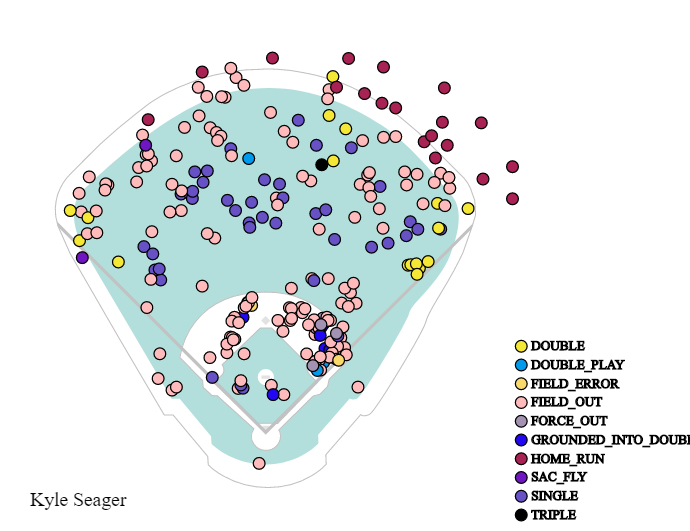
And here are some key numbers on Seager’s home runs to his pull side:
- Avg. exit velocity: 101.6 mph (19th percentile).
- Avg. distance: 382 feet (6th percentile).
- Avg. launch angle: 32.9 degrees (98th percentile).
- BA-xBA: .478 (93rd percentile).
Overall, his home runs have been (a) not hit all that hard, (b) not gone all that far, (c) been really, really high, and (d) according to xBA, about half of them shouldn’t have gone out. Dan Richards’ pHR (predicted home runs) also has him overperforming. He’s not overperforming as badly as his pull-heavy teammates Austin Nola (who has seven but whose pHR is zero), Omar Narvaez, and Daniel Vogelbach, but overall, in a neutral context, pHR thinks he should lose about four or five of his home runs (-4.50 pHR-HR).
So yes, Seager has made really interesting changes at the plate. That’s true. But he’s also had a ton of support because of the balls that are being used throughout the league.
Let me show you what this has looked like.
First, a home run off of Wilmer Font:
https://gfycat.com/obedientuntimelyamericangoldfinch
This is pretty much as close as it gets to literally scraping the wall—it’s as if it was dropped from directly above. xBA? .084, which means it had an 8.4% chance of being a hit. Additional specs: 98.1 mph exit velocity and launch angle of 40 degrees.
Next, off of Joey Lucchesi:
https://gfycat.com/uncomfortableknobbykakapo
Again, just a 98.1 mph exit velocity, and 40-degree launch angle. The result? The same xBA as the last: .084.
Matthew Boyd is the next victim:
https://gfycat.com/yawningfocusedafricanelephant
A few rows up into the seats, but this is also Comerica Park. xBA? .116.
The next one is a little wackier:
https://gfycat.com/grimslushyanchovy
Even though first baseman Tyler White lobbed this 63 mph pitch over the center of the plate, Seager only just gets it out. This batted ball nets an xBA of .171 because of a 100.5 mph exit velocity and 39-degree launch angle.
But perhaps none were as fortunate as this:
https://gfycat.com/jubilantimmaterialdegu
To be fair, in a lot of parks, this isn’t even fieldable. In any case, kudos to Seager for taking a ball and sending it deep the other way—something he rarely does.
At the end of the day, Kyle Seager has just gotten back to being, well, Kyle Seager. In 2017, he seemed to lean into a being fly-ball hitter, which was more or less a failed experiment. Then, in 2018, he not only dealt with a major injury but the percentage of plate appearances in which teams shifted him continued to climb. Now, he’s finally found his footing after finally experiencing a streak of good health and adjusting his approach as well as finding an appropriate balance of where he’s hitting the ball vertically (i.e., launch angle) and horizontally (i.e., spray direction or pulling/pushing the ball).
As I finish this piece, Seager has finished his night with two home runs (xBAs of .230 and .450) and boosted his season wRC+ up to 122. Sure, the juiced ball is holding his hand throughout all of this, but that’s also true of, say, Alex Bregman, to an extent. Regardless, Seager’s the first player in Mariners history with 20 or more home runs in eight straight seasons. He’s never been the sexiest player, but he sure is steady. If the juiced ball is staying around for at least another year, you can bet that Seager will continue to rake.
(Photo by Cliff Welch/Icon Sportswire)

